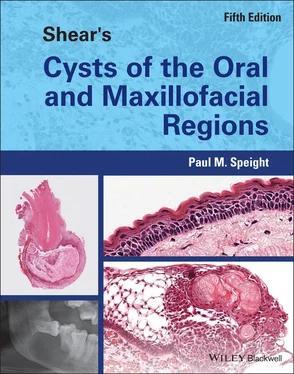Paul M. Speight - Shear's Cysts of the Oral and Maxillofacial Regions
Здесь есть возможность читать онлайн «Paul M. Speight - Shear's Cysts of the Oral and Maxillofacial Regions» — ознакомительный отрывок электронной книги совершенно бесплатно, а после прочтения отрывка купить полную версию. В некоторых случаях можно слушать аудио, скачать через торрент в формате fb2 и присутствует краткое содержание. Жанр: unrecognised, на английском языке. Описание произведения, (предисловие) а так же отзывы посетителей доступны на портале библиотеки ЛибКат.
- Название:Shear's Cysts of the Oral and Maxillofacial Regions
- Автор:
- Жанр:
- Год:неизвестен
- ISBN:нет данных
- Рейтинг книги:5 / 5. Голосов: 1
-
Избранное:Добавить в избранное
- Отзывы:
-
Ваша оценка:
- 100
- 1
- 2
- 3
- 4
- 5
Shear's Cysts of the Oral and Maxillofacial Regions: краткое содержание, описание и аннотация
Предлагаем к чтению аннотацию, описание, краткое содержание или предисловие (зависит от того, что написал сам автор книги «Shear's Cysts of the Oral and Maxillofacial Regions»). Если вы не нашли необходимую информацию о книге — напишите в комментариях, мы постараемся отыскать её.
Shear’s Cysts of the Oral and Maxillofacial Regions
Shear’s Cysts of the Oral and Maxillofacial Regions Fifth Edition
Shear's Cysts of the Oral and Maxillofacial Regions — читать онлайн ознакомительный отрывок
Ниже представлен текст книги, разбитый по страницам. Система сохранения места последней прочитанной страницы, позволяет с удобством читать онлайн бесплатно книгу «Shear's Cysts of the Oral and Maxillofacial Regions», без необходимости каждый раз заново искать на чём Вы остановились. Поставьте закладку, и сможете в любой момент перейти на страницу, на которой закончили чтение.
Интервал:
Закладка:
Although the paradental cyst is usually defined as arising on mandibular third molars, identical lesions have occasionally been described on second permanent molars when the third molar is absent and the second molar is the last standing tooth (Vedtofte and Praetorius 1989 ; Maruyama et al. 2015 ). Thus the definition of the paradental cyst might more appropriately refer to the ‘last standing mandibular molar tooth’. The vast majority, however, are located on third molars. The key features of the two main variants are summarised in Box 4.1and later Tables 4.2and 4.3.
Clinical Features
Most descriptions of inflammatory collateral cysts are to be found in single case reports or in small case series. In a review of the world literature, Philipsen et al. (2004 ) found 23 case reports and 18 case series reporting 377 cysts in 342 patients. More recently, Ramos et al. (2012 ) reviewed 16 reports (57 cases) of buccal bifurcation cyst. Selected case series, and the review of Philipsen et al. (2004 ), reporting paradental cysts and mandibular buccal bifurcation cysts are summarised in Tables 4.2and 4.3, respectively.
Frequency
Table 4.1summarises the reported frequencies of inflammatory collateral cysts in selected series from a wide geographical distribution. Data are taken from the same references shown in Table 1.3( Chapter 1) and from the frequencies encountered in the larger series shown in Table 4.2. Almost without exception, the authors of the papers cited in Table 1.3used ‘paradental cyst’ as a generic term for all inflammatory collateral cysts, so these frequencies include both paradental cysts and mandibular buccal bifurcation cysts.
The frequency ranges from 0 to 13.6% of odontogenic cysts ( Table 4.1). Those authors who presented series of paradental cysts found that they comprised between 3.0 and 4.7% of odontogenic cysts encountered in their departments (Craig 1976 ; Ackermann et al. 1987 ; de Sousa et al. 2001 ).
In Shear's large series of 3496 jaw cysts from South Africa (see Table 1.1), there were 109 inflammatory collateral cysts representing 3.1% of all jaw cysts and 3.6% of odontogenic cysts. In Craig's original series (Craig 1976 ), paradental cysts comprised 4.7% of 1051 odontogenic cysts, and in a recent study from the same department (Jones et al. 2006 ), a diagnosis of paradental cyst was made on 402 occasions over a 30‐year period (1975–2004), representing 5.6% of 7121 odontogenic cysts.
Box 4.1Key Features of the Two Main Clinical Variants of Inflammatory Collateral Cysts
| Paradental cyst | Mandibular buccal bifurcation cyst | |
|---|---|---|
| Site | Mandibular third molar | Mandibular first or second molar |
| % of ICC a | 61% | 36% |
| % of OC b | 4% | 0.2% |
| Location | Distal or disto‐buccal | Buccal |
| Proportion in males | 70% | 55% |
| Proportion bilateral | 4% | 25% |
| Clinical features | History of pericoronitis on a partially erupted tooth. Cyst is continuous with the pericoronal pocket | Swelling, painful. May be signs of infection and suppuration. Tooth tipped buccally, deep pockets in continuity with cyst lumen |
| Radiology | Well‐demarcated disto‐buccal radiolucency, superimposed over roots. Distal follicular space preserved | Well‐demarcated radiolucency over buccal aspect of roots, buccal expansion with corticated outline |
aFrequency as a proportion of inflammatory collateral cysts.
bFrequency as a proportion of all odontogenic cysts.
Table 4.1 Selected papers, with a wide geographical distribution, showing the frequency of inflammatory collateral cysts as a proportion of total odontogenic cysts. Based on Philipsen et al. (2004).
| Country | n | ICC (%) | |
|---|---|---|---|
| Data from references in Table 1.3 | |||
| Meningaud et al. (2006 ) | France | 695 | 0 |
| Tortorici et al. (2008 ) | Italy (Sicily) | 1273 | 0 |
| Ali (2011 ) | Kuwait | 196 | 0 |
| Ramachandra et al. (2011 ) | India | 252 | 0 |
| Manor et al. (2012 ) | Israel | 285 | 0 |
| Bhat et al. (2019 ) | India | 125 | 0 |
| Soluk Tekkeşin et al. (2012b ) | Turkey | 5003 | 0.2 |
| Daley et al. (1994 ) | Canada | 6847 | 0.5 |
| Grossmann et al. (2007 ) | Brazil | 2812 | 0.7 |
| Tamiolakis et al. (2019 ) | Greece | 5165 | 1.1 |
| Mosqueda‐Taylor et al. (2002 ) | Mexico | 856 | 1.4 |
| Aquilanti et al. (2021 ) | Italy | 2150 | 1.5 |
| Sharifian and Khalili (2011 ) | Iran | 1227 | 1.8 |
| Ochsenius et al. (2007 ) | Chile | 2944 | 3.8 |
| Jones et al. (2006 ) | UK | 7121 | 5.6 |
| Kammer et al. (2020 ) | Brazil | 406 | 13.6 |
| Data from references in Table 4.2 | |||
| Ackermann et al. (1989) | South Africa | 1852 | 3.0 |
| Craig (1976 ) | UK | 1051 | 4.7 |
| De Sousa et al. (2001 ) | Brazil | 1256 | 4.3 |
ICC, inflammatory collateral cysts; n, total number of odontogenic cysts in each study.
Few studies have determined separately the frequencies of paradental cysts and mandibular buccal bifurcation cysts. Tamiolakis et al. (2019 ) reviewed 5165 odontogenic cysts and found only 57 (1.1%) inflammatory collateral cysts. Of these, 53 were paradental cysts on third molars and only 4 were mandibular buccal bifurcation cysts in children, suggesting frequencies of 1.0% and 0.1%, respectively. Jones et al. (2006 ) used the term paradental cyst to encompass both types of inflammatory collateral cyst, but found only 15 cases in their paediatric population (patients ≤16 years), representing 2.7% of odontogenic cysts in children (n = 553) and only 0.2% of all odontogenic cysts (n = 7121). Paradental cysts in adults comprised 376 cases, representing 5.2% of odontogenic cysts. These data suggest that paradental cysts are about 10–20 times more common than mandibular buccal bifurcation cysts.
Overall, the data from these studies ( Table 4.1) suggest that inflammatory collateral cysts represent about 4% of odontogenic cysts. It is probable, however, that they are under‐reported, because many cases received within pathology departments may have insufficient clinical or radiological information to establish the diagnosis and many may have been diagnosed as inflamed dentigerous cysts, pericoronitis, or inflamed follicles. In departments where the diagnosis is made on a regular basis, the paradental cyst appears to be a common lesion. In the series of Colgan et al. (2002 ), paradental cysts comprised 15 of 60 (25%) cystic lesions associated with lower third molars. This was the second most common diagnosis after dentigerous cyst (30%).
In an analysis of pericoronal tissues from extracted third molars, Costa et al. (2014 ) found that 73.5% (83 of 113) showed pathological changes and of these, 55 (66.2%) were diagnosed as paradental cysts and 21 (25.3%) as dentigerous cysts. It should be noted, however, that the majority of lesions were associated with erupted or partially erupted teeth (85.5%), and only seven teeth were unerupted, suggesting that a number of dentigerous cysts were diagnosed in association with partially erupted impacted third molars. Mohammed et al. (2019 ) undertook a similar study and examined 407 tissue specimens associated with impacted teeth from 390 patients. The most common diagnosis was dentigerous cyst (56.5% of lesions; n = 230), followed by odontogenic keratocyst (6.1%) and then paradental cyst (5.7%; n = 23).
Читать дальшеИнтервал:
Закладка:
Похожие книги на «Shear's Cysts of the Oral and Maxillofacial Regions»
Представляем Вашему вниманию похожие книги на «Shear's Cysts of the Oral and Maxillofacial Regions» списком для выбора. Мы отобрали схожую по названию и смыслу литературу в надежде предоставить читателям больше вариантов отыскать новые, интересные, ещё непрочитанные произведения.
Обсуждение, отзывы о книге «Shear's Cysts of the Oral and Maxillofacial Regions» и просто собственные мнения читателей. Оставьте ваши комментарии, напишите, что Вы думаете о произведении, его смысле или главных героях. Укажите что конкретно понравилось, а что нет, и почему Вы так считаете.












